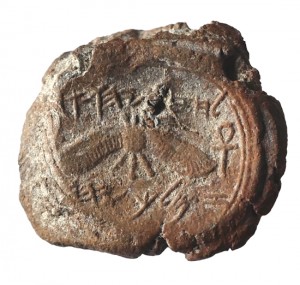×


We have detected your country as:
Please click here to go to the USA website or select another country from the dropdown list.
 The Ophel excavations at the foot of the southern wall of the Temple Mount, conducted under the direction of Dr. Eilat Mazar, have unearthed an impression of the royal seal of King Hezekiah (727698 BC).
The Ophel excavations at the foot of the southern wall of the Temple Mount, conducted under the direction of Dr. Eilat Mazar, have unearthed an impression of the royal seal of King Hezekiah (727698 BC).
Measuring 9.7 x 8.6 mm (.38 x .34 in), the oval impression was imprinted on a 3 mm (.12 in) thick soft bulla (piece of inscribed clay) measuring 13 x 12 mm (.51 x .47 in). Around the impression is the depression left by the frame of the ring in which the seal was set.
The impression bears an inscription in ancient Hebrew script:
לחזקיהו [בן] אחז מלך יהדה
“Belonging to Hezekiah [son of] Ahaz king of Judah”
and a two-winged sun, with wings turned downward, flanked by two ankh symbols symbolizing life.
 The bulla originally sealed a document written on a papyrus rolled and tied with thin cords, which left their mark on the reverse of the bulla. The bulla was found with 33 additional bullae imprinted from other seals, some bearing Hebrew names, their reverse showing marks of coarse fabric and thick cords that probably sealed sacks containing foodstuffs.
The bulla originally sealed a document written on a papyrus rolled and tied with thin cords, which left their mark on the reverse of the bulla. The bulla was found with 33 additional bullae imprinted from other seals, some bearing Hebrew names, their reverse showing marks of coarse fabric and thick cords that probably sealed sacks containing foodstuffs.
Dr. Eilat Mazar said: “Although seal impressions bearing King Hezekiah’s name have already been known from the antiquities market since the middle of the 1990s…this is the first time that a seal impression of an Israelite or Judean king has ever come to light in a scientific archaeological excavation.”
King Hezekiah is described in the Bible as a resourceful and daring king who, though he was an Assyrian vassal, successfully maintained the independent standing of the Judean Kingdom and its capital Jerusalem. The Bible says of Hezekiah that “there was none like him among all the kings of Judah after him, nor among those before him” (2 Kings 18:5).
Source: Excerpt from press release, Hebrew University
Photo Credit: Hebrew University
All logos and trademarks in this site are property of their respective owner. All other materials are property of Bridges for Peace. Copyright © 2025.
Website Site Design by J-Town Internet Services Ltd. - Based in Jerusalem and Serving the World.